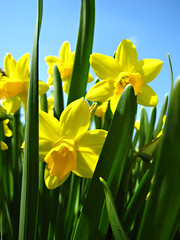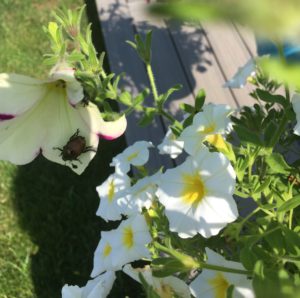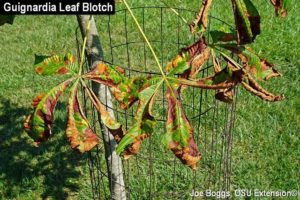Debby: the bug you have is called a Japanese Beetle. If there are many, they will defoliate a plant leaves quickly. The best and safest way to dispose of these rascals is to pick them off the plant and drop into a container of water with a few drops of dishwashing soap. (Wear disposable gloves if you are a bit squeamish). They will drown and die quickly. Another method is to hold the soapy water container under the leaves they are feeding on and lightly tap the leaves and the insect will drop straight down into the container. If all else fails several insecticides will kill the insects however, you run the risk of killing our precious bees, butterflies, and other pollinators if you spray the flowers with insecticides. If you must use an insecticide do not spray the flowers directly and minimize the number of times you spray.
Jan asks a question about Moon Flowers
This Question was submitted by Jan. Researched and answered by Advanced Master Gardener Elaine
What is your question for a Master Gardener?
Hi, I have a question about Moon Flowers. I have heard that their family member Trumpet Flowers are poisonous and I am wondering about the Moon Flowers. I have the bush variety growing in my garden and our son, who lives in Florida, wants some of the seeds to plant there. Do you know if they are an invasive plant in Florida? I don’t want to take him any seed pods if they are. They are a beautiful flower! Thank you
Jan,
Your son is in luck. Moonflower (Ipomoea alba) is native to subtropical regions of North and South America; that includes Florida. It is actually related to Morning Glory and can also be known as Tropical White Morning Glory. The only mention I can find of toxicity is that the plant has historically been used to produce rubber from the latex in its plant material. If you have a latex allergy, then it might be a plant to avoid.
If you are giving your son seed you have saved from your Moonflower, be sure to tell him to nick the outer coating of the seed with a file and then soak the seed overnight before planting. There are some species of plants that require this preparation in order to properly germinate. If he is using seeds from a nursery, the puncturing of the seed coating is usually done prior to packaging. It’s best to read the package instructions prior to planting.
I hope that answers your question. Thank you for submitting the question.
Elaine Whitfield
Hancock County Master Gardener Association
Brian wants to know what are the brown spots on his hydrangea
This question was submitted by Brian. Researched and answered by Advanced Master Gardener Darlene.
I realize that my hydrangea needs fertilizer, but what are the brown spots? They are more prominent on the top side of the leaf and less so on the underside. Is this insect damage? I’m in Cumberland on the east side of Indianapolis.

The spots on your hydrangea leaves are called Cercospora leaf spot. This disease affects most hydrangeas. If leaves become severely spotted they can become yellow-green in color and fall to the ground. From the photo, it looks like you have just a mild case. Since it is late in the season, I would not treat the shrub for this. The disease is spread by the spores that are blown by the wind, overhead irrigation and fallen infected leaves. Be sure to clear up all fallen infected leaves this fall. Then next spring you can apply nitrogen containing fertilizer and spray with a fungicide when the first signs of leaf spots appear. Tennessee State University has an excellent bulletin about this.
Click here for the link.
Can you help me identify this flower?
This question was submitted by Debby. Researched and answered by Advanced Master Gardener Bruce.
Can you help me identify this flower? When I bought it, they told me it was a princess lily. I’m not sure. I absolutely love it and want to purchase more but want to be looking for the right thing. Thanks in advance for your help!
 Hi Debby, Thanks for your question identifying the Lily picture you sent. It doesn’t look like a Princess Lily from the pictures I looked at. I think it is an Asiatic Lily named Levi. A Levi Lily can get up to 4 feet tall. Is you Lily rather tall? Click here for a link to compare .
Hi Debby, Thanks for your question identifying the Lily picture you sent. It doesn’t look like a Princess Lily from the pictures I looked at. I think it is an Asiatic Lily named Levi. A Levi Lily can get up to 4 feet tall. Is you Lily rather tall? Click here for a link to compare .
Sara is concerned-Black lilac leaves and growth on elm tree bark
Two questions submitted by Sara. Researched and answered by Advanced Master Gardener Darlene.
The leaves on my lilac are turning black. It is still in the pot that I got from the store about a month ago and waiting to plant it until Fall. What should I do for it?
The bark of this tree seems to have a growth all over it, What is it and what should I do? It is an Accolade Elm 2.5″
First one on the lilac
I’m not sure what is wrong with the lilac leaves. I would like a photo of the underside of the leaves as it may be an insect or it could be a fungal disease. How often has this lilac been watered and how much sun is it getting? It may just need to be planted but I would like to see the underside of the leaves before you do anything.
Second on about the bark on a elm
The growth on this tree is lichens. Lichens are using the tree as a substrate, a place to live. They also live on rocks. Lichens do not harm the tree, nor do they get nutrients or water from the tree. Often lichens are on trees that are having other health issues, but they are not causing these health problems. Penn State Extension has a good video on this subject: Click here
Debbie’s “Bigleaf” hydrangeas did not bloom at all this year
This question was submitted by Debbie. Researched and answered by Advanced Master Gardener Darlene.
My “Bigleaf” hydrangeas did not bloom at all this year.; Abracadabra,,Quick Fire, Cityline. Nothing but leaves. Last year, I did not trim after Fall. This Spring I let them come up on their new wood , as usual & nothing. Previously, they were beautiful. Your thoughts, please. Thank you.

Photo Credit Missouri Botanical Garden
Bigleaf hydrangeas, especially Abracadabra and Cityline, bloom on old wood. Do not trim these after August 1. They should be trimmed after they bloom. However, Quick Fire blooms on new wood in the spring, so it can be trimmed one third its length in the early spring or right after it blooms. These hydrangeas need 4 to 6 hours of sun and bloom best with 6 hours or more. They need moist, well-drained soil. Be sure they get 1-2 inches of water each week. Fertilize in the spring and late summer with a 10-10-10 fertilizer. It can take 3 or 4 years for this plant to get established and bloom. It may need some protection from harsh winters. We did have a late frost this past spring which could have cause the plant to lose its flowering buds.
Can you identify this flower? I have no clue.
This question was submitted by Barbara . Researched and answered by advanced Master Gardener Bruce.
What is your question for a Master Gardener?
Can you identify this flower? I have no clue.

Hi Barbara, Thanks for your question. The flower is called a Five Spot. It is native to California but is used a lot in wildflower mixes, flower mixes, etc.
The mix may not have been sowed this year. It could be from a previous year. This link gives more information about the Five Spot. Click here
I hope this answers all your questions. Let us know if we can be of further assistance.
Bruce
Susan is concerned about her brown Buckeye tree leaves.
What is your question for Ask A Master Gardener
We have a buckeye tree that is looking mostly brown. I am afraid it is dying. This spring it bloomed and looked healthy. It is by a creek so it seems to have an adequate water supply.
Response by Advanced Master Gardener Darlene
There could be a couple reasons for the brown leaves, but without a photo of the leaves one can’t be sure. One reason could be leaf scorch. If it is planted in full sun, the leaves can be scorched by the hot, dry summers. To resolve this, you could plant another tree or shrub that will provide some shade. If it is planted where there is some shade but it has wet weather, the plant may have acquired one of the several fungal pathogens that thrive in wet conditions. One of those is Guignardia aesculi; the fungus responsible for Guignardia Leaf Blotch of Aesculus. In the winter, the disease remains on the fallen leaves that are infected and then in the spring spores are released and affect the new leaves. If this is what your tree has, then this fall rake and remove all the fallen leaves so the fungus is less likely to affect the new leaves next spring. Below is a photo of the disease.
Sara asks questions about flowering bulb’s .
This question was submitted by Sara. Researched and answered by Advanced Master Gardener Darlene
What is your question for a Master Gardener?
Flower bulbs. When do I plant them and where can I find a list of bulbs that will grow in New Palestine IN and their light requirements? I love spring flowers and peonies (which I don’t think grow from bulbs but I want to plant some). Thanks

Most flowering bulbs are planted in the fall. Purdue has an excellent list of flowering bulbs with their light and soil requirements. Click here for the Purdue information. If you have further questions after reading this information, feel free to contact me again. You are correct: peonies are not grown from bulbs. By the way, Hancock County Master Gardeners are having a fall plant sale and will have some peonies for sale. The plant sale will be online and can be accessed on the Hancock County Master Gardener website http://Hancockmga.com
Barbara asks why second year Columbine is not blooming.
This question was submitted by Barbara. Researched and answered by Advanced Master Gardener Elaine.
What is your question for a Master Gardener?
I have what looks to be a columbine plant that I planted from seed. This is the second year for it and I thought it would bloom this past spring but it did not. Why? It is very large. I live in Indy

Barbara,
In answer to your question about the Columbine you started from seed, (and, yes, the picture you sent is definitely Columbine) I would be patient. When started from seed, Columbine may not bloom until the second or third year. They are short-lived perennials but, fortunately, are prolific re-seeders. I would say that your plant should bloom next Spring. Then prepare for many more Columbine coming up the following year. I’ve had them come up between the cracks in the sidewalk. They can tolerate a variety of conditions and are practically pest-free, except for leaf miners. In the wild, I’ve seen them growing in dense, dry shade out of the side of a sheer rock clift. The garden variety seem to have retained that spunky DNA.
Your Columbine looks healthy in the picture so it has probably been spending the last couple years developing a good root system. More than likely, you will be rewarded with beautiful blooms next Spring.
Thank you for visiting our website.
Elaine
Hancock County Master Gardener Association
- 1
- 2
- 3
- 4
- Next Page »

